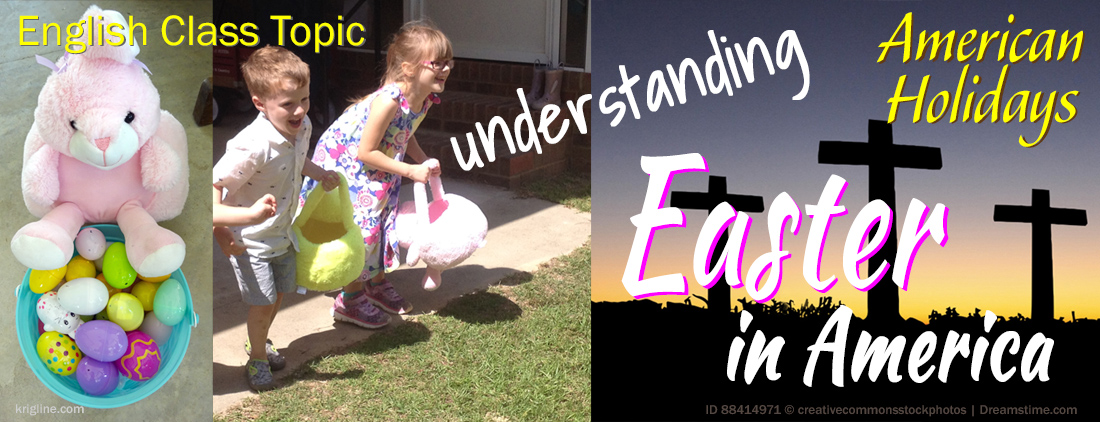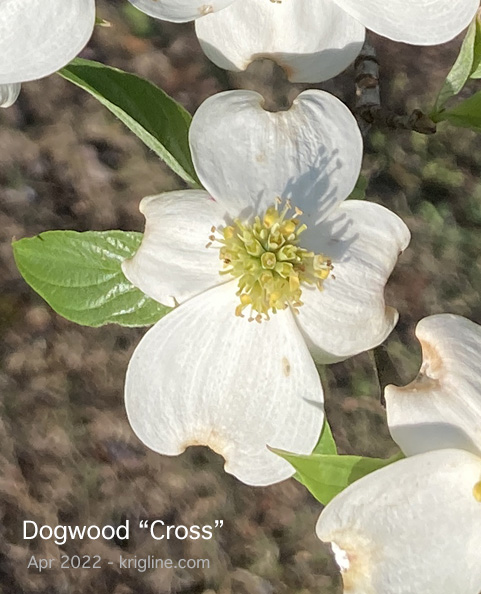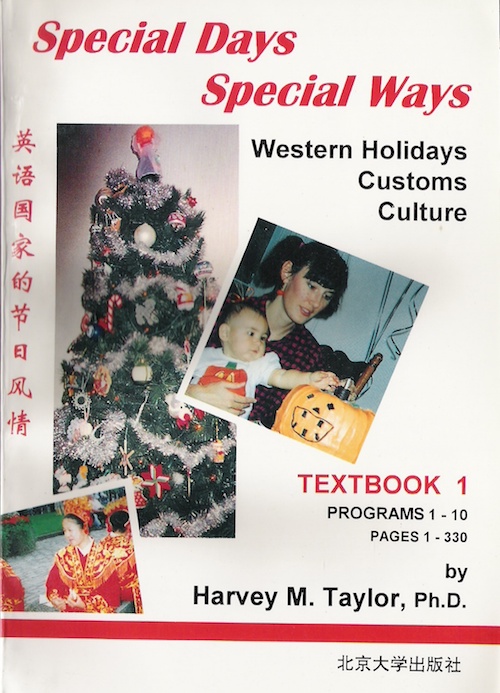Easter (Resurrection Day)
Spring-time holiday celebrating LIFE ⇔
 Holiday: Easter (Resurrection Day)
Holiday: Easter (Resurrection Day)© April 2022 Michael Krigline & Dr Harvey Taylor
Underlined terms are explained in the vocabulary section below. Note to teachers: This post contains an article and discussion questions, suitable for conversational English classes, followed by more information (from Dr Harvey Taylor) that would work well in a class about American history & culture.
Easter in America (See below for Dr Taylor’s summary)
(by Michael Krigline)
Like Christmas, Easter (or Resurrection Day) has a secular and a sacred side. The secular side is for small children, who focus on eggs, baby animals, and Easter candy. The sacred side is for everyone who wants to honor Jesus, whose life was so influential that his birth split time between BC and AD.
When and what is Resurrection Day (Easter)?
The spring-time date is determined by a lunar calendar, like many international festivals. Easter falls on the first Sunday after the first full moon after March 21. Historically, Easter has always been the celebration of Jesus’ death and resurrection, an event linked to the Jewish lunar holiday “Passover.”
The sacred holiday starts a week before Easter. On “Palm Sunday” Jesus entered Jerusalem with friends waving palm branches to welcome him. On Thursday, many meet to share Communion, remembering the “Last Supper” Jesus shared with his disciples. The next day is “Good Friday,” remembering the day Jesus was crucified. Resurrection Sunday is celebrated as the day Jesus rose from the dead. The day of Jesus’ death is called “good” because the Bible teaches that Jesus’ painful death paid the penalty for our sin; and his resurrection opened the door of heaven for all who believe.
Since Easter always comes in the spring, secular Easter traditions often focus on “new life.” You’ll see decorations with pastel-colored flowers, eggs and various baby animals, and children often get new springtime clothes. The lily is a popular Easter flower. Many churches decorate with dozens of these flowers every Easter. White dogwood-tree blossoms are also popular at Easter time. People say its shape reminds them of the cross, and the “marks” on the petals look like nail holes with blood stains.
Eggs are a symbol of “hope” (because there is “life” inside them, even though you can’t see it). Centuries ago, Easter eggs were painted red to remind people of the “blood of the cross,” but over the centuries they became more colorful (and now coloring eggs is an activity for children).
 On Easter morning, children hunt for Easter eggs “left by the Easter bunny,” and eat chocolate bunnies and marshmallow chicks. Many churches or communities welcome local kids to search for hundreds of plastic, candy-filled eggs.
On Easter morning, children hunt for Easter eggs “left by the Easter bunny,” and eat chocolate bunnies and marshmallow chicks. Many churches or communities welcome local kids to search for hundreds of plastic, candy-filled eggs.
Lambs are also a symbol of Easter, in part because on Passover a lamb was sacrificed. When ancient people sacrificed lambs they were really saying “sin is costly, so I shouldn’t sin.” The Bible says that “without the shedding of blood, there is no forgiveness.” Jesus was also called “the lamb of God,” whose sacrifice paid for sin. That’s another reason why sheep and lambs are popular Easter symbols (and Easter meals).
But the heart of Easter is a Sunday celebration of what happened three days after Jesus died: the Bible says that God raised or “resurrected” him from the dead. That is why it is called “Resurrection Day.” Churches have a big celebration, with banners, special songs, dramas, flowers, and more. No other religious leader claims to have died and rose again. If this really happened, could anything else be as important? It would mean that the death we all fear has been conquered, and the one who arose could provide answers to what happens after death.
Well, I hope you’ve learned something about this important international holiday. And whether your Easter focuses on the historical, Christian holiday, or the secular “Easter bunny” side, just remember that Easter is a world-wide holiday to celebrate sacrifice, forgiveness, “new life” and hope. Happy Easter!
Vocabulary: (underlined terms are in either the article above or below)
- blossom: a flower on a tree or bush
- Christian: someone who believes in the basic truths of the Christian Bible (see footnote*)
- Communion: (also called Eucharist/the Bread and Wine): a religious practice that helps all Christians worldwide remember the final meal Jesus shared with his followers, and how Jesus’ sacrifice saved them and unites them, regardless of their differences (Jesus said, “Do this in remembrance of me. This is my body, given for you. This is my blood, which is shed for the forgiveness of sins.”)
- to conquer: to defeat an enemy (e.g., an army, fear, a difficult language); to succeed in doing something very difficult that no one did before (e.g., conquer a mountain)
- to crucify: to put to death, specifically by nailing a man’s hands & feet to a wooden cross (a common way that Romans killed prisoners in the first century)
- disciples: students who strongly believe in the teachings of a leader, philosopher, etc. (such as Confucius or Jesus)
- to hunt: to look carefully for sth, esp. an animal
- Passover: an important annual Jewish festival, remembering when their ancestors were saved from slavery in Egypt
- pastel: a light color, such as the light pinks and blues of spring flowers
- sacred: holy; of the utmost value according to religious teachings (the opposite of “secular”)
- secular: not religious; not related to sacred practices/gods/faith/etc.
- sin: human imperfection. According to the Bible, sin is every human act that falls short (“misses the mark”) of the perfection God intended for humans; all sin separates people from God, and the only way to “pay” for sin was through blood sacrifice
- tomb: place where a dead body is put
(See discussion questions below)
~ ~ ~ ~ ~ ~ advertisement ~ ~ ~ ~ ~ ~
Discussion:
- If there is a holiday in your country in early spring, tell your partner about it.
- Other than spring flowers, baby animals and eggs, what other things symbolize “new life” or “hope” to you?
- Candy is a popular part of Easter celebrations. What is your favorite kind of candy? (If you have tasted Easter candy, describe it to your partner.)
- In your culture, what sorts of things are “sacrificed” (or perhaps, were sacrificed in previous times)? What is the purpose of these sacrifices? Is that different from what this article says about sacrifice? Explain.
- Do you consider yourself to be a disciple of a certain teacher, philosophy, etc? If so, explain.
- What is “sin,” according to the article? Are you a sinner? explain.
- What is something you have hunted for? Tell your partner about it.
- Christian believe that Jesus really did rise from the dead, and “pay” to create a path to heaven. Does this make you curios to know more about him? Why or why not?
Activity: If you have any questions about Easter, Passover, Communion, sin, heaven, or other things mentioned in the article, do some research and write a paper or paragraph about it in English.
Easter Day
(Based on “Special Days Special Ways” ©Dr Harvey Taylor, Peking University Press)
Easter itself is the 1st Sunday after the 1st full moon after March 21st (the beginning of Spring), but many people include the preceding Thursday and Friday in their celebration, as well as the 39th day afterward.
1) This holiday began in about 30 A.D. when Jesus Christ died and was “resurrected” (came alive again). The following points describe the main events that took place (in Jerusalem, Israel) according to the Bible. At the bottom you will learn about other modern Easter traditions.
THE LAST SUPPER (THURSDAY)
2) When Jesus was about 33 years old, one Thursday evening he ate a special Jewish meal with his 12 best friends (his “followers” or “disciples”). Most Christians call this “The Last Supper” since it was the last meal Jesus ate with these men before he died.
3) One of the men who ate this last supper was named Judas. He kept the bag that held the money for the group. Judas, however, would often steal money from the bag to use for himself.
4) At the supper, Jesus said that one of those eating with him would turn against him and help his enemies. Jesus then told Judas to go and quickly do what he wanted to do. The other disciples thought that Jesus was telling Judas to buy something or to give some money to poor people.
5) But Judas had already told the Jewish leaders that he would help them catch Jesus, and so they had given him some money. He left the supper early to guide them. (This is why anyone who turns against a friend is called “a Judas.”)
GOOD FRIDAY
6) Jesus often went with his 12 disciples to a big garden of olive trees. Judas brought soldiers to that garden so they could catch Jesus. From the garden, the soldiers took Jesus first to one group of leaders and then to some others.
7) The religious leaders in Jerusalem hated Jesus. They wanted him to be killed the Roman way. Roman soldiers nailed non-Roman criminals to a wooden cross and left them there until they died, but only the Roman Government could sentence someone to this horrible death.
8) So, the Jewish leaders took Jesus to the Roman governor named Pilate. They told the people to call out, “Crucify him! Crucify him!”
9) Pilate knew that Jesus had not done anything wrong deserving a death penalty. He wanted to let Jesus go free, but someone shouted that if Pilate let Jesus go, Pilate would be helping an enemy of the Roman Government. So Pilate agreed to have Jesus severely beaten and then crucified (to be nailed to a wooden cross to die).
10) The soldiers made Jesus walk from the city carrying his own cross. Jesus’ mother Mary and many other people followed Jesus to a hill. There the Romans crucified Jesus between two criminals on their crosses.
11) Then, even though it was in the afternoon, the sky suddenly became dark. Jesus called to God his father, and in a loud voice said that he was giving his spirit into God’s hands. Then Jesus died.
THE CAVE
12) Two other friends of Jesus took Jesus’ body down from the cross. They wrapped it in some cloth and put it in a small cave (or tomb). Mary and other women watched while soldiers rolled a large stone across the front of the cave.
13) Jesus had said that after he died, he would come alive again. So, the Jewish leaders told Pilate that Jesus’ disciples might steal his body and then say that he was alive again. Therefore, Roman soldiers watched the cave.
14) Why is it called “good” Friday? Jesus died so God could forgive the sins of the people in the world. For this reason his horrible death was good for other people. Christians all over the world now call this day “Good Friday.”
RESURRECTION SUNDAY
15) Two days after Good Friday is Easter Sunday. The story of this Sunday begins early in the morning with an earthquake. Then an angel came from heaven and rolled the stone away from the front of the cave.
16) When the Roman guards saw that the cave was open and empty, they went and told the Jewish leaders what had happened. The leaders gave the soldiers a large amount of money so they would say that Jesus’ disciples had taken Jesus’ body away while the guards were asleep.
17) A little later some women came to the cave. When they saw the angel, they were afraid. He told them not to be afraid. He knew they were looking for Jesus, but Jesus had come alive again. He had been resurrected.
18) The angel told them to go quickly and tell his disciples that Jesus was alive and would meet them. Over the next few weeks Jesus was seen by many of his followers. He taught them many things about the future.
19) In many languages of the world, the day of Jesus’ resurrection is called “Resurrection Sunday.” It remembers the greatest miracle in the Christian teaching — the resurrection of Jesus Christ. But in English it is usually called “Easter Sunday.”
20) True Christians believe that this event actually happened. Without the resurrection of Jesus Christ, Christianity has no real meaning. So this is the most important day of the year for Christians.
21) One day, about five weeks after his resurrection, Jesus was talking with many of his followers. While he was talking to them, he went up into the sky — he “ascended into heaven.” And so, Christians around the world celebrate the 39th day after Jesus’ resurrection as his “Ascension Day.”
MODERN EASTER
22) Easter in North America and Europe has both Christian beliefs and many non-religious customs. It is a happy Christian holiday mixed with other modern customs that are not Christian.
23) Some early Christians thought that the hatching of a hen’s egg was like the resurrection of Jesus from the cave. So, on Easter Sunday, boiled eggs can have that special Christian meaning.
24) But most Easter eggs have no Christian meaning. Stores sell Easter eggs made of chocolate or colored candy. Children color boiled eggs before Easter, as kids in many countries do just for fun. American children are told that the “Easter Bunny” hides colored eggs for them to find on Easter morning.
25) Both Christians and non-Christians send Easter greeting cards. Many cards have pictures or words about the resurrection, an empty cross, the women at the empty cave, etc. Other cards are about Easter rabbits, colored eggs, baby chickens, and spring flowers.
26) On Easter Sunday, children will hunt for colored eggs and eat candy, while adults will buy spring flowers, wear new clothes, and enjoy the warm sunny weather. People around the world also sing Christian songs during this special Easter holiday season.
HAPPY EASTER TO YOU!
Note to teachers: This holiday summary is © Dr. Harvey Taylor; used here with permission. You can find more of Dr. Taylor’s holiday summaries at EFLsuccess.com and on my old website. Dr. Taylor is the author of “Special Days – Special Ways: Western Holidays, Customs, Culture.” This teaching resource contains two textbooks and a video tape with 20 programs, produced at the request of the China TV Teacher’s College, and designed to be the cultural component of a 3-year middle school English teachers’ video course. These resources are available in China. Dr. Taylor’s most recent teaching position in China was at Kunming University; he is now retired and living in the western United States (you can reach him by writing to me).
*Footnote: The basic truths of the Christian Bible include: (1) Jesus is part of the Trinity; (2) that sin (human imperfection) makes a human-God relationship as impossible as a relationship between a dirty stick and a hot fire; (3) that Jesus’ death on the cross brings forgiveness of sin to anyone who believes; and (4) that Jesus’ was raised from the dead to show God’s power, both to do miracles and to forgive sin, and thus to allow sinful humans to nonetheless have an eternal relationship with a holy God. (A Christian is not simply someone born in a western culture, but someone who is an intentional, personal follower of Jesus and his teachings.)
For more information about Christianity, check out https://peacewithgod.net/
(Other Easter resources: Easter for Kids 中文; Easter for Kids (English); article about The Passion–with Emperor Kangxi’s poem)
EFLsuccess.com; ©Michael Krigline and Harvey Taylor, all rights reserved. This resource was created for our students under my understanding of “fair use” for educational resources. As far as I am concerned, people are allowed to print/copy it for personal or classroom use. See our Website Standards and Use Policy.
~ ~ ~ ~ ~ ~ advertisement ~ ~ ~ ~ ~ ~



